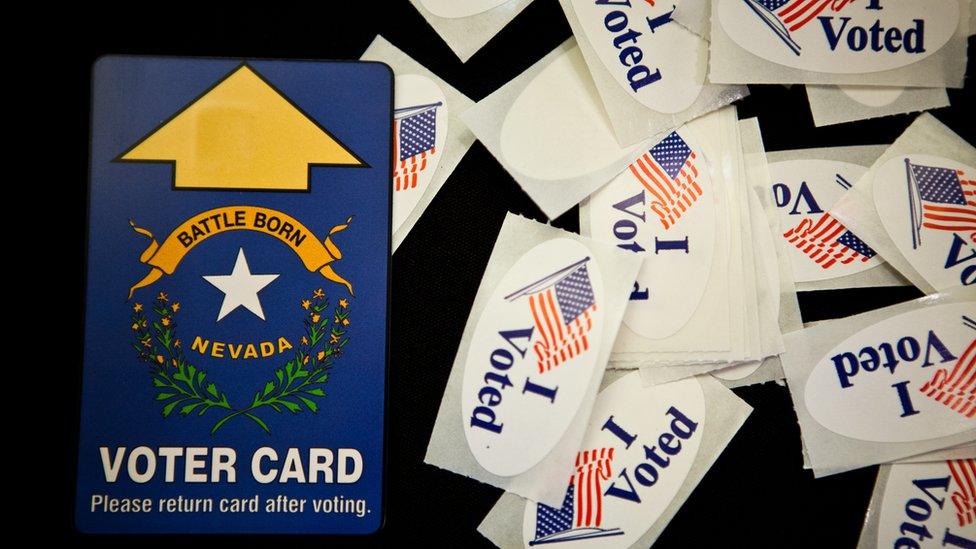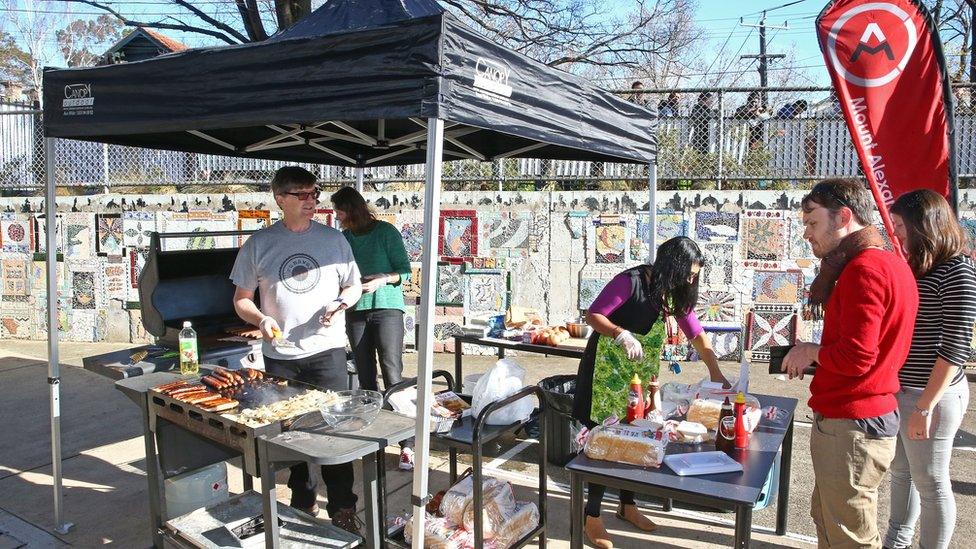US election: Why does the US have such low voter turnout?
- Published
Australia discuss whether mandatory voting would work in the US
After a long campaign, it's less than two weeks before millions of Americans cast their votes. But turnout could be as low as 50%. Why do so few people vote?
With two of the most unpopular presidential candidates in history, some pundits are concerned there could be a record low in voter numbers.
Turnout has been on a historic downward trend in recent years - with the exception of President Barack Obama's 2008 campaign, said David Becker, the executive director of the Center for the Election Innovation and Research.
Participation has hovered between 48% and 57% in US presidential elections since 1980. That contrasts with France, where turnout regularly tops 80%.
Among OECD countries, the US ranked 31 of 34 for percentage of voting-age population.
Americans face a number of hurdles beginning with registration. The US is one of the only countries that requires voters to register separately, rather than automatically signing them up, a step many Americans never take.
"The burden has always been on the voter to find out how to register and get themselves registered," Mr Becker said.
But some US states have taken efforts to make this process easier by implementing "same-day registration" or allowing people to register to vote while getting a driver's licence.
Other states have passed more stringent voter ID laws, which some critics say make it more difficult for minorities to cast a ballot.
More recently, Pew Charitable Trusts worked with several states to form the Electronic Registration Information Center (ERIC), to help update voter registration rolls.
Twenty-one states and the District of Columbia now work with ERIC, which Mr Becker helped create, and somewhere between 10 and 20 million people will have been contacted to register by this fall.
And though Democratic political data firm TargetSmart found that 200 million Americans are now registered to vote for the first time in US history, that may not translate to turnout.
Some critics also point to holding elections on Tuesdays, when much of America is at work, as part of the challenge.
To resolve scheduling conflicts, some states offer absentee ballots, or voting by mail, as well as early voting, but in places like Australia, where voting is mandatory, the election is held on a Saturday.
The historical lack of enthusiasm for voting in the US has been heightened in this year's bitter presidential election - which has seen gruelling months of mudslinging and a rise in hateful invective - leaving some voters no other option than to tune it out.
Courtney Otto, a 29-year-old resident who lives in Romeoville, Illinois, said she plans to abstain from voting on 8 November for that very reason.
"I'm not informed. I feel like both candidates are more so telling me what the other candidate has done wrong," she told the BBC.
"I don't want to know what the other person's not going to do. I want to know what you are going to do."
She is not alone. Brian Meyer, a 32-year-old resident in southeast Wisconsin, has also decided to not to vote in the presidential election for the first time since he was 18.
Mr Meyer, a former Bernie Sanders supporter who has been unable to throw his support behind either candidate, said his decision not to vote was his form of protest.
"This is my way to protest the system for throwing American people overboard," he said.

Estimates show somewhere over 50 million eligible voters are not registered in the US
But even this year's primaries only saw about 30% of eligible voters at the polls, which means seven out of 10 people did not show up, Mr Becker noted.
"If you don't like the candidates who came out of the primary process, I think it only highlights the importance in that primary process and making sure your voice is heard," he said.
Compare US turnout rates with Australia, where mandatory voting has increased average turnout to 91% from 67%. Failing to vote in Australia is punishable with a fine of A$20.
Compulsory systems consistently rank among the world's highest voter participation.
President Barack Obama once said of compulsory voting: "If everybody voted, then it would completely change the political map in this country."
Simon Jackman, a professor and chief executive of the United States Centre at the University of Sydney, said the process has even become part of the Australian identity.
"It's become so engrained in the political consciousness now," he said. "If it's going to be compulsory, you have to make it easy and in the course of making it easy I think it's helped institutionalise this norm of high voter turnout in Australia.
Doug Morris, a 35-year-old American living in Sydney, Australia, finds the concept a little strange for a democratic society, but said it serves as a good reminder about US voting.
"I honestly feel more of a sense of duty about voting being overseas than I would being in Chicago," he said, referring to his hometown.
"Voting isn't necessarily a duty: I think it's a right. But I think if you take up that right, it's your duty to understand who you're voting for and why. And, if you choose not to vote, I think it's your duty to explain why you haven't."

Volunteers cook sausages at a "sausage sizzle" as people vote in the national election at a polling station in Melbourne, Australia
But by requiring people to vote, Mr Jackman contended, it validates the outcome.
"I think a lot of Australians who point to Americans who may be upset with the outcome of their elections say, 'well, if you don't vote then you don't really have a legitimate gripe about it'".
"They tend to make it an event," Mr Morris said, recalling his first experience with Australian voting 10 years ago.
Voters often head to the pub after casting their ballot while charities set up cookouts outside the polls.
"It was a real diversion from what I was used to back in the States and there was a hopeful enthusiasm about it," he said.
But in the US, the decision is on the voter - a principle that underscores American democracy but could undermine the outcome in November.
"The onus is on the citizen in the United States," Mr Jackman said. "For younger people who aren't paying a lot of attention to politics, that's a deal breaker."